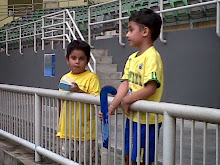27/08/2003
THE International Hockey Federation (FIH) dealt Malaysia a severe blow
when its Executive Board outlawed the changing of sticks during penalty
corners and strokes effective Jan 1, 2004.
Malaysian skipper S. Kuhan has been steadily improving his penalty
corner conversion rate by using a curved stick during penalty corners but
the FIH has killed what could have been a great advantage for Malaysia in
the Madrid Olympic Qualifiers in March next year.
Kuhan, clearly disappointed with the FIH decision when met yesterday,
could only shake his head in disbelief when told of the new ruling.
"Just when things started looking better for me during penalty corners,
such a ruling had to be passed by the FIH. I have no choice but to start
practicing with my playing stick after the Asia Cup next month," said
Kuhan.
The national skipper scored six penalty corner goals during the recent
Champions Challenge - by making full use of his reserve hockey stick which
was lighter and had a slight curve which gave maximum power during flicks
Two other penalty corner specialists also affected are Pakistan's Sohail
Abbas and German Florian Kunz.
Both the players change their sticks during penalty corners and have
been scoring regularly in tournaments.
Malaysian Hockey Federation secretary S. Satgunam, who is aware of the
new ruling, could not shed light on it. But the MHF has decided to do away
with the `three man' ruling which was experimented with during the
Malaysia Hockey League.
"Since there was no mention about the three man ruling (which only
allowed eight players to remain in their own half and defend at all times)
we will only enforce it for the duration of the MHL, but do away with it
for the Razak Cup," said Satgunam.
It was also reported on the FIH website that: "The FIH Executive Board
has recommended that further study be undertaken to examine the
technological feasibility of the use of a third, video umpire to assist
with major umpiring decisions."
FIH's Umpiring Committee began experimenting with the technology since
the Women's World Cup in November 2002 and experimenting continued at the
Azlan Shah Cup in January 2003. Limitations have been encountered in the
level of assistance that hockey's current video technology is able to
provide.
(END)
skip to main |
skip to sidebar



The Blogger's Family

The Blogger at the top of the 4,095m Mount Kinabalu in Sabah on June 13, 2008. This was the second climb. The first was in 1993.


TBSS was established in 1924, and this blogger studied there from 1981-1987.
RESPECTABLE LINKS
Kuala Lumpur |
ESPECIALLY FOR U, MR RACIST...

I PISS ON.....

Hockey News
ALWAYS HAPPY

The Blogger's Family
ON A HIGH

The Blogger at the top of the 4,095m Mount Kinabalu in Sabah on June 13, 2008. This was the second climb. The first was in 1993.
Always Somewhere..

- Jugjet Singh
- Sports Journalist with the New Straits Times since 1994. My main beat is field hockey, so this blog will have stories that I have written for the NST, as well as hockey news from around the globe. There will be regular updates. I was also the Secretary General of the National Press Club, Malaysia for three terms (six years).
Live Traffic Feed
Blog Archive
- ► 2018 (212)
- ► 2016 (241)
- ► 2015 (299)
- ► 2014 (260)
- ► 2013 (445)
- ► 2012 (564)
- ► 2011 (430)
- ► 2010 (504)
- ► 2009 (467)
- ▼ 2008 (270)
Tunku Besar Secondary School, Tampin.

TBSS was established in 1924, and this blogger studied there from 1981-1987.